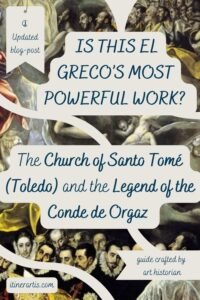Famous Art, Forgotten Corners: 10 Must-Visit Spain Art Museums (The Ultimate List for Art Lovers Who Crave Meaningful Travel)
We all think we know them. The big names. The “must-sees.” They’re on every list, whispered through guidebooks, immortalized in postcards—the Spain art museums that house the country’s most iconic works. But step through their doors—and pause—and something shifts. The crowds blur, the echoes fade, and suddenly, it’s just you and the art. A flicker of gold leaf. A whisper of brushwork. A story left unfinished.
![Twilight view of the Guggenheim Museum Bilbao, Spain [Photograph]. Credit: PA. Licensed under CC BY-SA 4.0](https://itinerartis.com/wp-content/uploads/2024/05/1.-Twilight-view-of-the-Guggenheim-Museum-Bilbao-Spain-Photograph.-Credit-PA.-Licensed-under-CC-BY-SA-4.0.jpg)
This isn’t about unveiling secret museums no one’s heard of. It’s about looking closer. Because even the most famous art museums in Spain—the Prado, the Reina Sofía, the Guggenheim—still carry quiet mysteries. A hallway you missed. A sculpture that didn’t speak to you last time, but does now. These aren’t just places to admire famous art in Spain; they’re spaces to feel something: awe, reflection, connection.
So, if you’re one of those art lovers who prefer moments over checklists—and travel that lingers longer than a caption—this list is for you. These Spanish art museums aren’t just buildings filled with masterpieces. They’re living archives of beauty, history, and wonder, waiting to be rediscovered.
Post last updated on March 27, 2025 (originally published on May 21, 2024) by Roberta Darie.
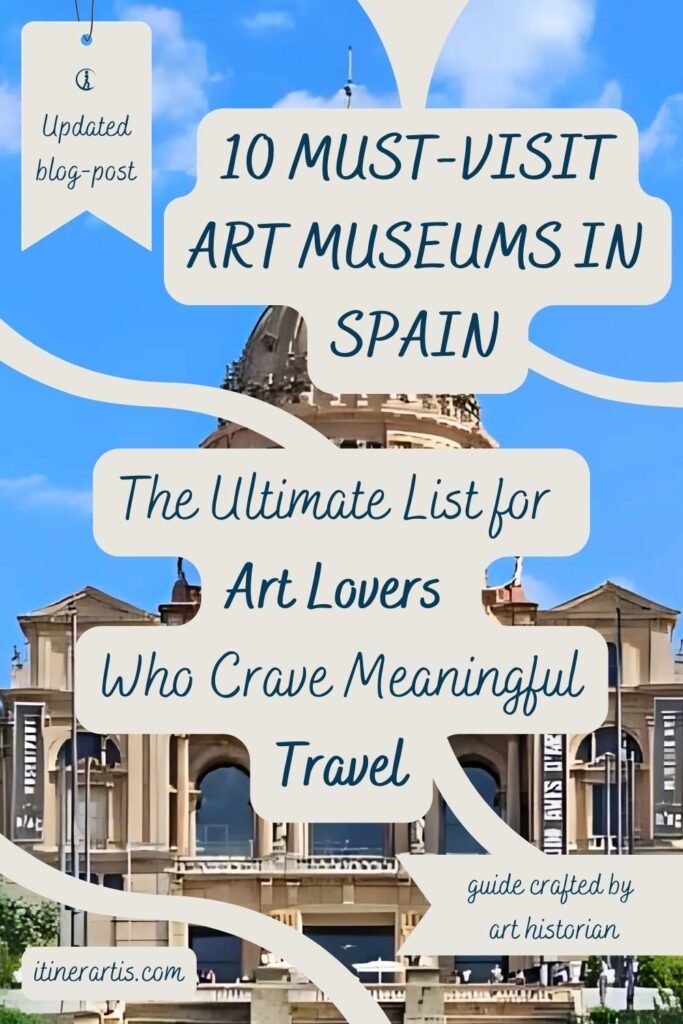
- A Canvas Stretched Across Centuries: Why Spain’s Art Museums are Worth Visiting?
- 1. The Prado Museum, Madrid – Royal Canvas of the Spanish Soul
- 2. Museo Reina Sofía, Madrid – Where Modernism Meets Memory
- 3. Guggenheim Museum, Bilbao – A Building That Became Art
- 4. Picasso Museum, Barcelona – Tracing Modern Genius in Gothic Alleys
- 5. MNAC, Barcelona – Catalonia’s Time Capsule of Art
- 6. Dalí Theatre-Museum, Figueres – Welcome to the Surreal Side of Spain Art Museums
- 7. Fine Arts Museum, Granada – Hidden in the Alhambra’s Shadow
- 8. IVAM, Valencia – Spain’s Rebel Modern Art Museum with a Cause
- 9. Museum of Fine Arts, Seville – Baroque Brilliance in a Convent Cloister
- 10. El Greco Museum, Toledo – Where Mysticism Found Its Master
- Art Meets Place – Why Spain Art Museums Belong on Your Travel Itinerary
- Rediscovering Wonder, One Spain Art Museum at a Time
“Art enables us to find ourselves and lose ourselves at the same time.”
— Thomas Merton

A Canvas Stretched Across Centuries: Why Spain’s Art Museums are Worth Visiting?
Spain is a country where time doesn’t just pass—it layers. Roman mosaics lie beneath Gothic cathedrals. Moorish arches give way to Baroque altarpieces. And somehow, all of it speaks in the same breath. That’s the quiet magic of Spain art museums: they don’t just show art—they show time, tangled and beautiful.
For art lovers, few countries offer such a rich, contradictory palette. You’ll move from the spiritual mysticism of El Greco to the royal realism of Velázquez; from Goya’s unflinching brush to the surreal labyrinths of Dalí. Whether it’s a medieval fresco in a dim chapel or a modernist sculpture catching sunlight in Bilbao, famous art in Spain rarely sits still. It questions, provokes, and often reveals more than expected.
Where Art Belongs: When Museums and Place Become One
But what truly sets Spanish art museums apart is how seamlessly they inhabit their spaces. A museo nacional inside a royal palace. A contemporary center tucked beside a centuries-old monastery. Art lives here—in courtyards, crypts, and avant-garde galleries. It’s not just on walls; it’s in the air.
So yes, these may be some of the most famous art museums in Spain. But their fame isn’t their final word. For those who take the time to look closer, they offer something rarer: intimacy, depth, and the chance to feel history through the heartbeat of paint, stone, and silence.
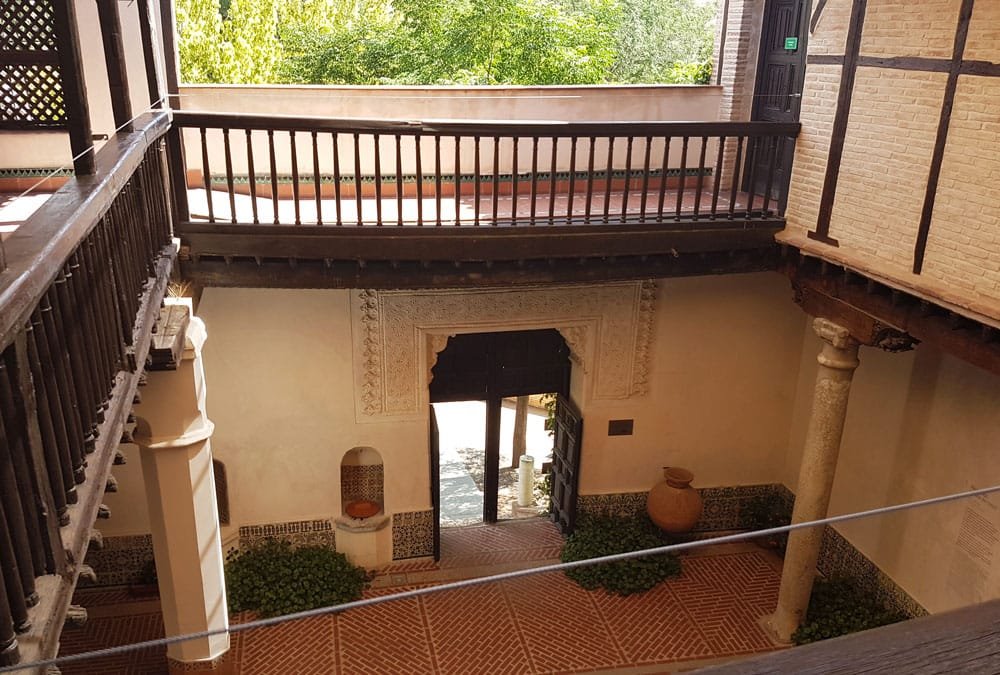
1. The Prado Museum, Madrid – Royal Canvas of the Spanish Soul
Step inside the Prado, and history doesn’t whisper—it speaks in oil and shadow. Opened in 1819 as a royal collection, this neoclassical building holds over 8,000 paintings, though only a fraction are ever on display. Still, even a quiet walk through its galleries feels like flipping through Spain’s memory—kings and queens, saints and sinners, their lives stilled in brushstrokes.
Set in the heart of Madrid’s Paseo del Arte, the Prado is often listed as one of the most famous art museums in Spain, and one of the most important in the world. But that’s not really the point. The real magic begins when the marble fades into the background, and you find yourself alone with a painting. Just you, and a centuries-old moment, waiting to be seen again.
Inside the Prado – Confessions in Oil and Gold Leaf
Here, famous art in Spain comes alive: Velázquez’s Las Meninas invites you into a painted illusion, where reality plays second fiddle to perspective. Goya’s The Third of May 1808 doesn’t just depict war—it wounds you. And Bosch’s The Garden of Earthly Delights? It’s a fever dream of faith and folly that still defies explanation. Each gallery is a chapter, each canvas a confession. But look closely, and you’ll find quieter treasures too: forgotten saints, gentle Madonnas, Dutch still-lifes glowing with domestic beauty.
For art lovers, the Prado is essential. But it’s best savored slowly. Arrive early, ideally on weekdays. Allow at least half a day—three hours minimum. The museum spans 45,000 square meters (484,000 sq ft), and rushing it would be like skimming a novel in bold. This is a place to pause, to ponder, to look twice. The Prado isn’t just one of the most famous art museums in Spain. It’s where the country paints its soul.

2. Museo Reina Sofía, Madrid – Where Modernism Meets Memory
If the Prado speaks of kings and saints, the Reina Sofía hums with protest, dreams, and doubt. Housed in a former hospital just south of Atocha station, this museo nacional of modern art feels different from the moment you arrive. Its industrial glass elevators and quiet courtyards create space to reflect—even before you step inside. Founded in 1992, the museum now forms a cornerstone of the Paseo del Arte, reminding us that Spain art museums aren’t just about the past—they’re about how the past unsettles the present.
Here, famous art in Spain takes a different shape. Picasso’s Guernica, perhaps the most haunting painting of the 20th century, dominates the central gallery. It’s massive—3.5 meters tall and 7.8 meters wide (11.5 x 25.5 feet)—and yet, the real weight comes from the silence it demands. Across the museum’s wings, you’ll find Dalí’s surreal experiments, Miró’s symbols, and Ana Mendieta’s quiet, revolutionary gestures. These works don’t decorate—they disturb, provoke, and call you in.
For art lovers who lean toward the bold and the strange, this is essential ground. Go early or midweek for a quieter visit, and allow at least 2–3 hours. The Reina Sofía isn’t just one of the most famous art museums in Spain—it’s one of the most necessary. Here, the art remembers questions we sometimes forget to ask.
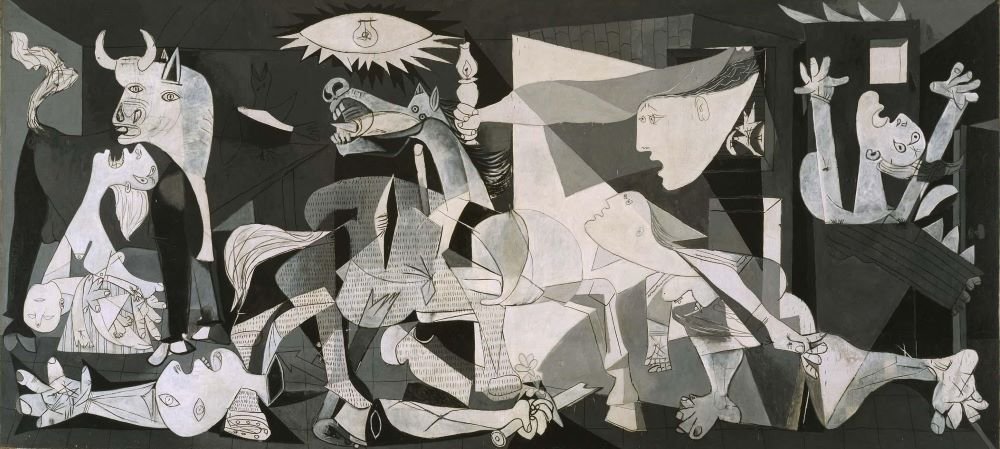
3. Guggenheim Museum, Bilbao – A Building That Became Art
Some museums hold masterpieces. The Guggenheim Bilbao is one. Rising from the Nervión River like something part shipwreck, part sculpture, this titanium-clad marvel redefined not just a city, but how the world thinks about Spain art museums. Designed by Frank Gehry and opened in 1997, the Guggenheim isn’t just a stop on the map of Spain art museums—it’s a pilgrimage for those who love when architecture and art blur into one. A museum that, even before you walk in, already begins telling its story.
Step inside, and the narrative continues—loud, strange, and unforgettable. Richard Serra’s The Matter of Time invites you to walk through its spiraling steel forms—art you experience with your whole body… Louise Bourgeois’s towering spider, Maman, guards the outside plaza like an elegant, terrifying myth. And Jeff Koons’ flower-covered Puppy still greets visitors with a cheeky smile and no explanation. These aren’t just installations; they’re interruptions—reminders that famous art in Spain doesn’t always hang quietly on walls.
For art lovers seeking the new, the bold, and the boundary-breaking, this is essential ground. The museum sits in the heart of Bilbao’s revitalized cultural center, making it easy to explore on foot. Visit in spring or early autumn to avoid heavy crowds and bask in the soft northern light. Among all Spanish art museums, the Guggenheim stands apart—not just for what’s inside, but for how it makes you feel before you even enter.
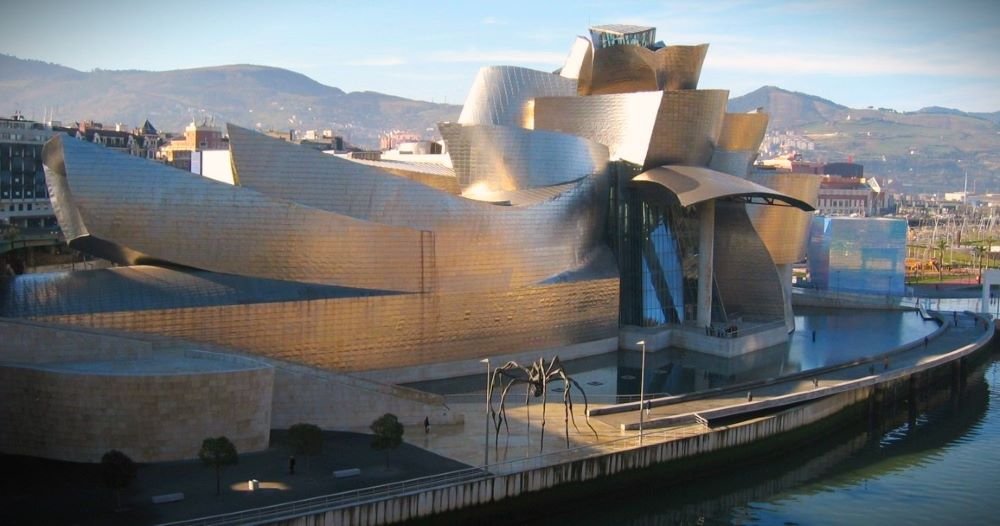
4. Picasso Museum, Barcelona – Tracing Modern Genius in Gothic Alleys
Among medieval arches and stone façades of El Born quarter, the Picasso Museum blends into the heart of old Barcelona. Housed across five medieval palaces, this Spanish art museum feels less like an institution and more like a labyrinth of memory. It’s a fitting tribute to an artist who, despite becoming a global icon, always carried Barcelona in his bones.
Unlike other Spain art museums, this one doesn’t begin with fame. It starts with youth—sketchbooks, classroom studies, early portraits of pigeons and family members. These works, some dating back to when Picasso was barely a teenager, reveal a raw, searching brilliance. The jewel of the collection is his Las Meninas series: 58 radical reinterpretations of Velázquez’s royal masterpiece, made in 1957. Through them, we watch a master not just imitate, but interrogate—challenging tradition with every stroke. It’s one of the most insightful windows into famous art in Spain because it shows a genius still learning.
For art lovers seeking intimacy, this museum offers a rare kind of closeness—not just to Picasso, but to the creative process itself. Visit during weekday mornings to avoid crowds, and give yourself at least two hours. The museum isn’t vast, but its atmosphere lingers. Like much of Spanish art, it reveals its power slowly—in shadowed corners, unfinished canvases, and questions left mid-sentence.
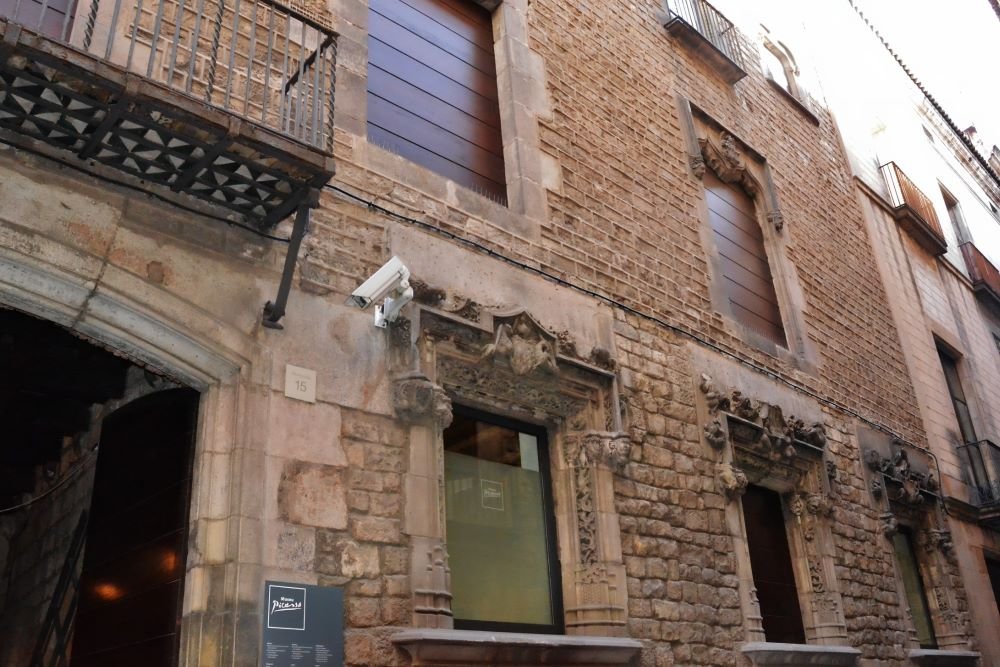
5. MNAC, Barcelona – Catalonia’s Time Capsule of Art
The climb up Montjuïc is gentle, but something shifts as you reach the top. The Palau Nacional rises ahead—grand, yes, but weathered. Familiar. Like a place you’ve never been but somehow remember. Inside, the Museu Nacional d’Art de Catalunya (MNAC) unfolds not as a single story, but as a layered conversation—across centuries, styles, and silence.
This isn’t the kind of museum where you rush from room to room. It asks you to slow down. The Romanesque collection alone, pulled from crumbling Pyrenean churches, holds some of the oldest surviving frescoes in Europe. Their saints are strange and still, staring out with wide eyes and knowing expressions. In nearby rooms, Catalonia’s modernist heart beats through the works of Ramon Casas and Santiago Rusiñol. And there, tucked between the expected names—El Greco, Zurbarán—you’ll find surprises that may linger longer than the famous highlights. That’s the beauty of art in Spain: it doesn’t always announce itself.
Among Spanish art museums, MNAC is quiet but unshakable. It’s for art lovers who enjoy wandering without a map—those who find meaning in the overlooked. Visit in the late afternoon, when the light pours in through high windows and the city stretches out below. Let the view pull you in. Then let the art hold you there, a little longer than planned.
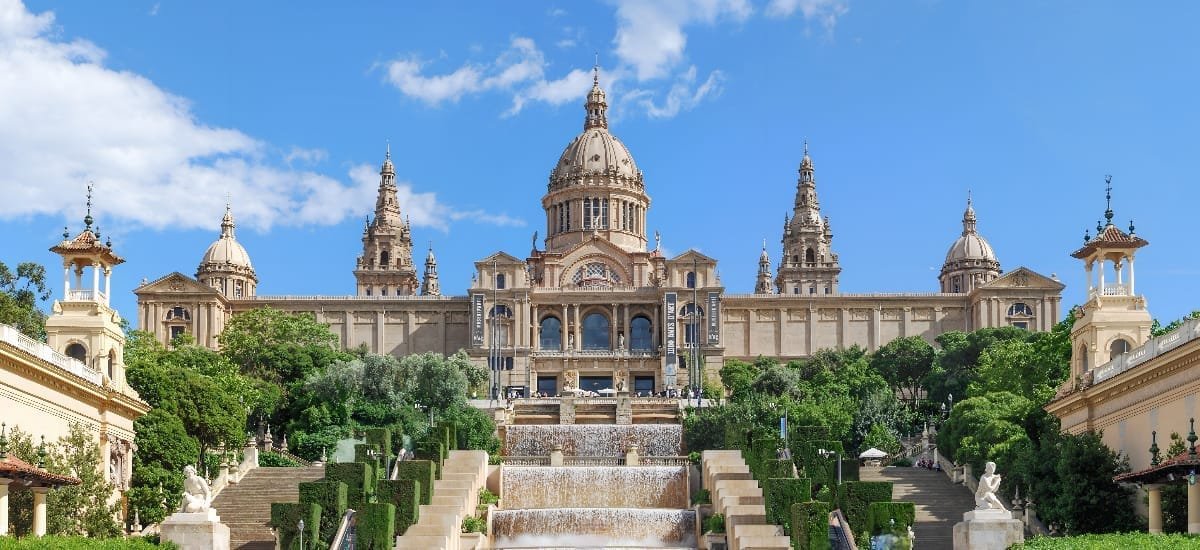
6. Dalí Theatre-Museum, Figueres – Welcome to the Surreal Side of Spain Art Museums
At first, you’re not sure if it’s a museum or a dream someone forgot to wake up from. The Dalí Theater-Museum rises in the center of Figueres like something imagined during a fever—pink walls, giant eggs, golden bread. And somehow, it works. This is Dalí’s hometown, after all, and he built this space not just to house his work, but to become part of it. Among Spain art museums, there’s nothing more personal—or peculiar.
Inside, things don’t get clearer. A Cadillac rains indoors. A theater stage becomes a tomb. A face turns into a living room, if you look from the right angle. It’s easy to lose your bearings here, but maybe that’s the point. Dalí wanted confusion, curiosity, contradiction. The museum holds over 1,500 works, from early drawings to some of the strangest famous art in Spain. There are moments of brilliance, yes—but also plenty of play.
For art lovers who prefer questions to strict answers, this is a place to wander. Give it a few hours. Go early. Let yourself be surprised, or unsettled, or both. Because this isn’t a museum in the usual sense—it’s a mind turned inside out. And like all the best Spanish art museums, it doesn’t just show you art. It asks you to feel your way through it.
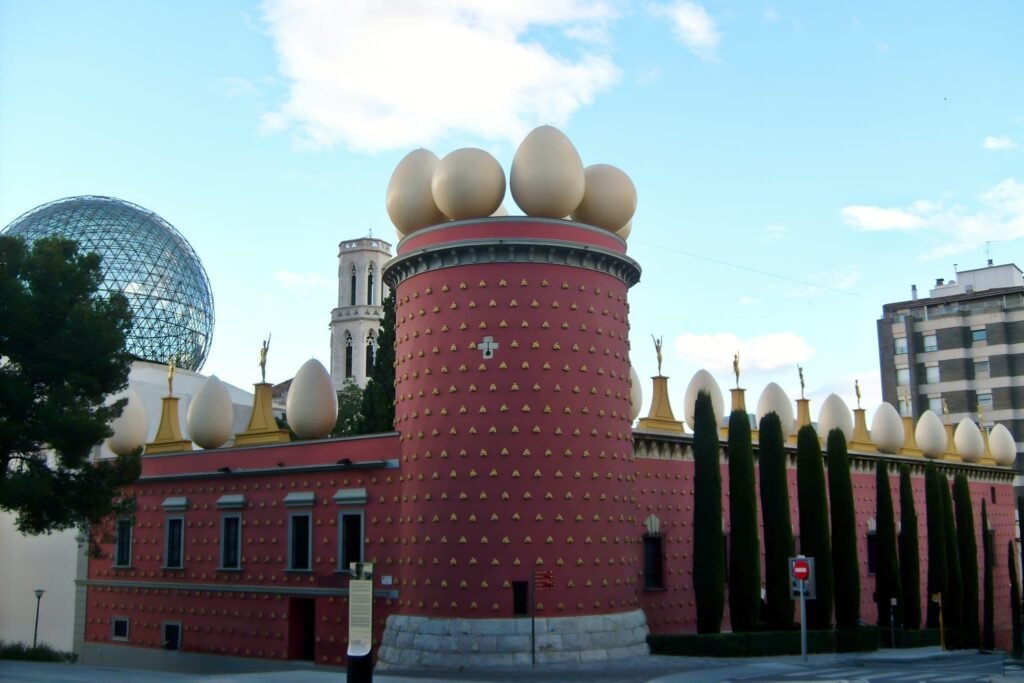
7. Fine Arts Museum, Granada – Hidden in the Alhambra’s Shadow
Most visitors come to the Alhambra for its palaces. Few wander into the museum quietly tucked inside the Palace of Charles V. And yet, the Museo de Bellas Artes de Granada holds something the courtyards can’t: the emotional afterimage of centuries past. Among Spain art museums, it may be one of the most overlooked. Which makes discovering it all the more rewarding.
The building itself is a paradox—Renaissance austerity set within Nasrid splendour. Inside, the collection begins in the Gothic period and winds gently toward the 20th century, with a strong focus on Andalusian painting and sculpture. Alonso Cano, both architect and painter, is the soul of the museum. His Virgin with the Child (ca. 1650) isn’t just technically brilliant—it’s tender, quiet, and deeply human. Alongside Cano, you’ll find works by Pedro de Mena, Mariano Fortuny, and local artists whose names are less known but no less worthy. Though this is famous art in Spain, it is told softly rather than shouted.
For art lovers who travel to feel rather than collect, this museum offers space to slow down. Go in the late morning, when the light is gentle and the crowds still linger in the Generalife. Admission is often included with Alhambra tickets. And the reward? A moment of stillness, where Spanish art museums whisper stories often missed in the grandeur next door.
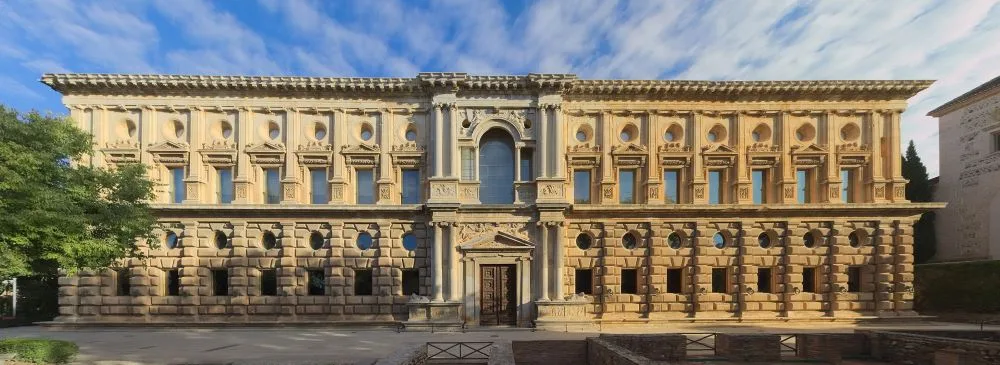
8. IVAM, Valencia – Spain’s Rebel Modern Art Museum with a Cause
In the heart of Valencia, far from the grandeur of royal portraits and medieval saints, IVAM (Institut Valencià d’Art Modern) pulses with a different energy. Opened in 1989, it was Spain’s first museum dedicated to modern and contemporary art. And it still feels like a place in motion—a site where ideas, not traditions, take the lead. Among Spain art museums, IVAM is the one that raises its hand and asks, “What if?”
Its permanent collection includes works by Julio González, a Valencian sculptor who helped shape the language of modernism. His forged iron forms—industrial, abstract, strangely tender—anchor the museum’s spirit. Nearby, pieces by Ignacio Pinazo offer a softer rebellion: lush, loose brushstrokes that predated impressionism. Temporary exhibitions expand across movements and continents, often confronting political or social themes. This isn’t just a place for famous art in Spain; it’s where Spanish artists wrestle with what it means to make art now.
For art lovers curious about the edges of the canvas, IVAM is a must. Go during the week for quieter halls, and expect to spend at least two hours. It’s not a large museum, but it lingers. And like the best Spanish art museums, it reminds you that art doesn’t only preserve the past—it dares to imagine something different.
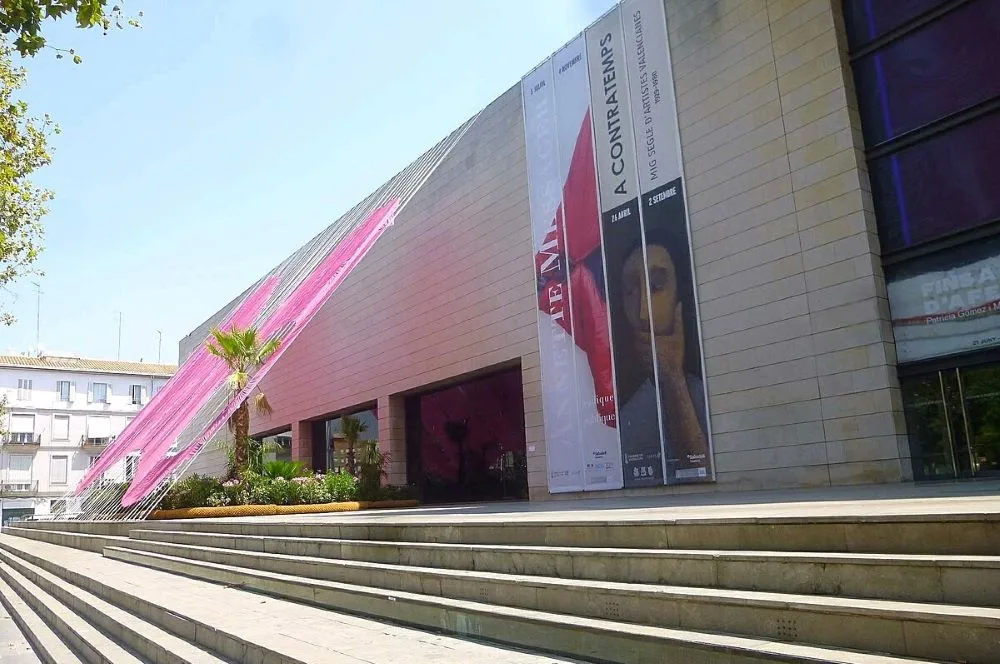
9. Museum of Fine Arts, Seville – Baroque Brilliance in a Convent Cloister
Seville hums with music and orange blossoms, but step through the quiet courtyard of the old Convent of La Merced and time slows. The Museo de Bellas Artes de Sevilla, founded in 1839, is one of the most important Spanish art museums, yet it often feels like a well-kept secret. Sunlight spills into the cloisters. The hush of worn tiles and ancient stone offers a kind of reverence—not just for art, but for where it lives.
Inside, the Baroque reigns. Murillo, Seville’s poetic master of light, is everywhere—his Madonnas glowing, his beggar boys full of warmth and mischief. Nearby hang the works of Zurbarán, austere and powerful, and Valdés Leal, who doesn’t shy away from death’s shadow. These are not just famous paintings in Spain; they’re windows into the spirit of Andalusia—dramatic, tender, unafraid of contrast.
For art lovers with a taste for stillness and soul, this museum is a gentle revelation. It’s best visited on a weekday morning when the rooms are quiet and the light soft. Allow time to sit in the courtyard. Let the art echo. Among Sevillian art museums, few offer such an intimate dialogue between building, city, and brushstroke.
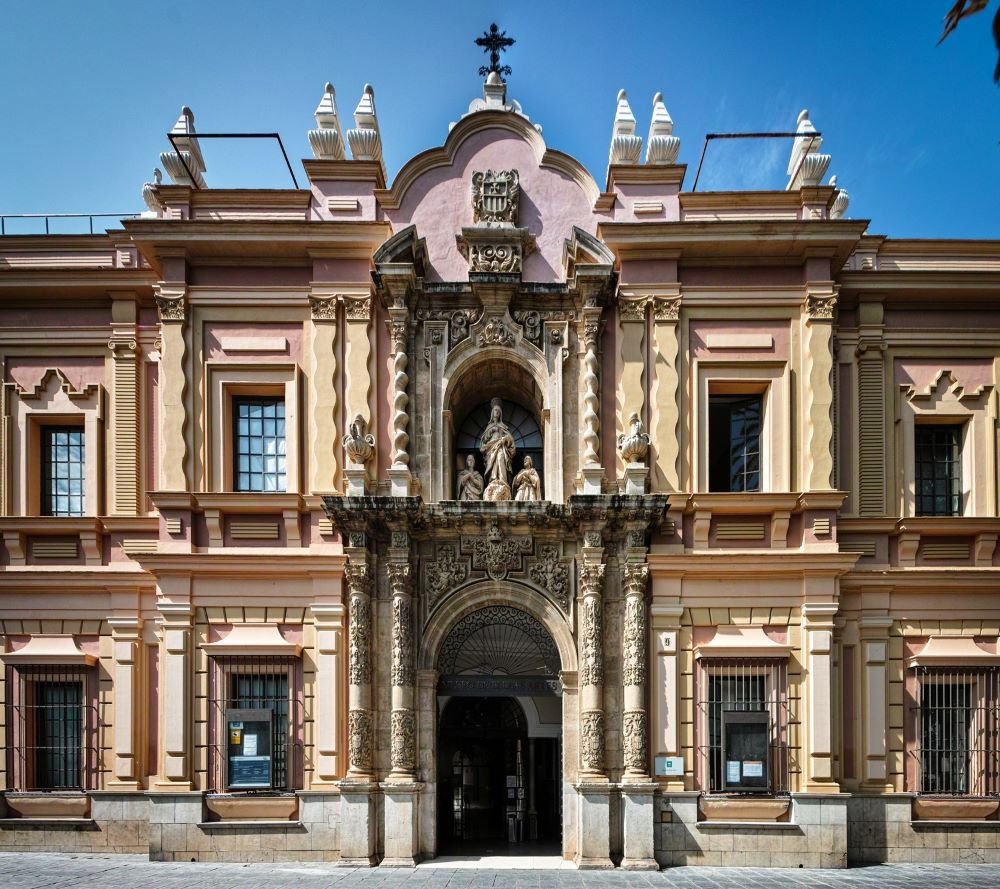
10. El Greco Museum, Toledo – Where Mysticism Found Its Master
Toledo doesn’t unfold all at once. Its streets twist and tighten, its stones hold onto shadows. Somewhere within that tangle, the Museo del Greco waits—quiet, unassuming, almost shy. It doesn’t pretend to be a grand museum. It doesn’t need to.
Though not his original home, the building stands near where El Greco lived and worked. Inside, the air feels hushed, thick with reverence and old dust. His paintings line the walls—not many, but enough. And what they lack in number, they more than offer in presence. The Apostles stand elongated, otherworldly, like flames made flesh. Faces flicker with light and grief. His View and Plan of Toledo hangs like a storm that never clears—green hills bruised with clouds, the city not seen so much as felt. Among all famous art in Spain, few works speak this strangely, or this deeply.
This is not a monumental museum. And that’s exactly the point. For art lovers who seek more than scale—for those who want to understand why a place mattered to an artist—it’s worth the visit. Go in the late afternoon, when the crowds have thinned. Let the quiet speak. In a country of cathedrals, this little museum is more like a chapel: simple, strange, and deeply human.
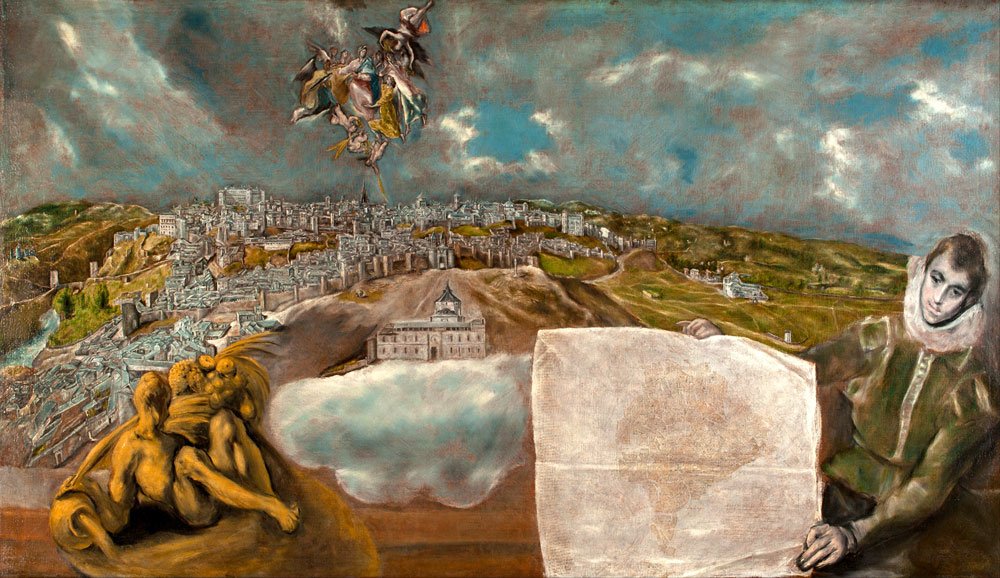
Art Meets Place – Why Spain Art Museums Belong on Your Travel Itinerary
In Spain, museums don’t stand apart from life—they’re stitched into it. You find them in former convents, forgotten palaces, repurposed hospitals. Sometimes, they surprise you—a doorway tucked into a quiet square; a grand staircase worn by centuries of footsteps. Even the most famous art museums in Spain feel connected to place, shaped by it, softened by time.
That’s part of their magic. You can step out of a gallery and hear a guitarist tuning up in the street. Or pause before a painting, only to realize the same light slanting across the canvas is filtering in through the museum window. These aren’t just places to look at famous art in Spain. They’re places where art and setting lean into one another—where what you see is inseparable from where you see it.
Spanish Art Museums: Where Stillness Becomes Story
For art lovers who prefer travel that moves slowly—who enjoy sitting longer than planned in front of a single canvas—these museums offer space. Not just physical space, but mental space. A rhythm that’s quieter, more deliberate. And sometimes, unexpectedly moving.
You don’t need to understand it all. That’s not the point. But if you let yourself linger—in a cloister, a hallway, a shadow—you might notice that in Spanish art museums, the building speaks too. And often, it whispers something you didn’t know you were waiting to hear.

Rediscovering Wonder, One Spain Art Museum at a Time
You’ve likely heard of these places before. The great Spain art museums that fill guidebooks, bucket lists, and Instagram grids. But maybe now, you see them differently—not as boxes to tick, but as places to return to. To linger in. To listen closely. Even the most famous art museums in Spain still hold stories that only reveal themselves when you’re ready to notice.
From Gothic frescoes to surrealist dreams, from dim cloisters to titanium curves, each museum on this list offers more than just famous art in Spain. They offer context. Emotion. A sense of time folding in on itself. Whether it’s El Greco’s haunted skies in Toledo or the golden hush of MNAC’s Romanesque halls, Spanish art museums don’t just preserve the past—they invite you to step inside it.
So go. Wander without urgency. Get lost in a hallway that smells faintly of varnish and stone. Stay longer than you meant to in front of something you don’t fully understand. Let your feet ache a little. Let the silence do some talking. Because even in the most photographed, most famous corners of these Spain art museums, something unexpected can still meet you—if you’re paying attention. And maybe that’s what art is about. Not to be conquered or explained, but to be lived with. To be moved by it—slowly. Quietly. In your own time.


